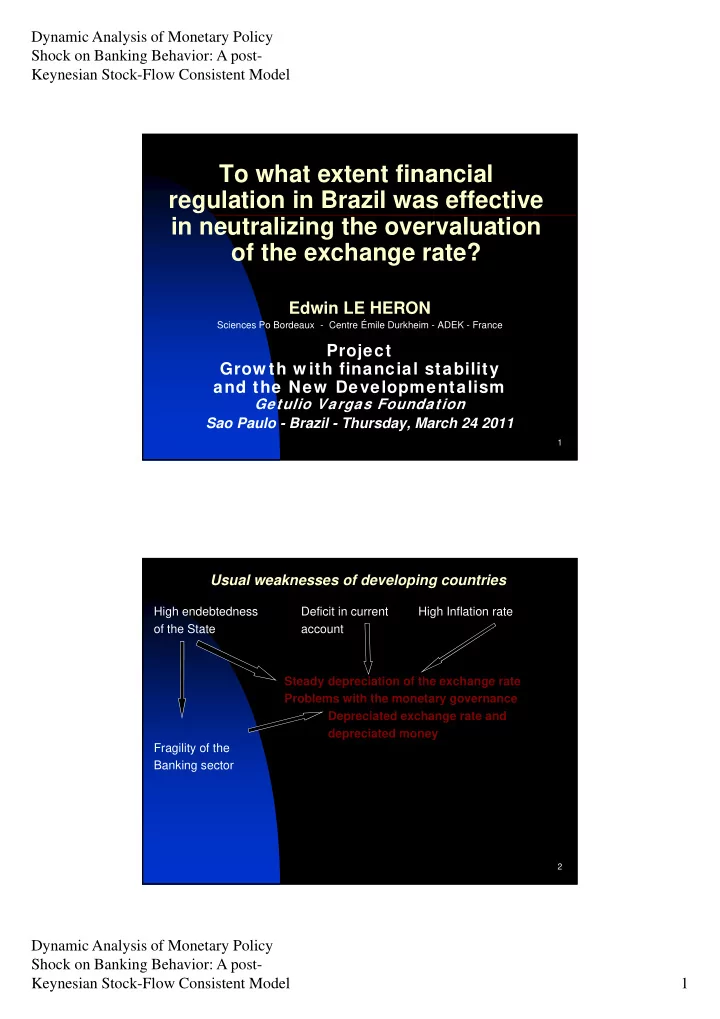

Dynamic Analysis of Monetary Policy Shock on Banking Behavior: A post- Keynesian Stock-Flow Consistent Model To what extent financial regulation in Brazil was effective in neutralizing the overvaluation of the exchange rate? Edwin LE HERON Sciences Po Bordeaux - Centre Émile Durkheim - ADEK - France Project Grow th w ith financial stability and the New Developmentalism Getulio Vargas Foundation Sao Paulo - Brazil - Thursday, March 24 2011 1 Usual weaknesses of developing countries High endebtedness Deficit in current High Inflation rate of the State account Steady depreciation of the exchange rate Problems with the monetary governance Depreciated exchange rate and depreciated money Fragility of the Banking sector 2 Dynamic Analysis of Monetary Policy Shock on Banking Behavior: A post- Keynesian Stock-Flow Consistent Model 1
Dynamic Analysis of Monetary Policy Shock on Banking Behavior: A post- Keynesian Stock-Flow Consistent Model Second consensus of Washington Financing High interest rates Overvaluation of By foreign savings (nominal and real) exchange rate Industrial exports Fragility in the Extortion of domestic Banking sector profits (debt in international Currency) and in the sovereign debt (original sin) LOWER GROWTH RATE 3 Three important mistakes or three false solutions To finance the growth with foreign savings (from the North) To consider the exchange rate as being determined only on a market, with complete freedom of capital circulation To confuse a powerful State with an important fiscal deficit or to think that State is the problem and not a solution Plus a ‘specific’ Brazilian problem (Dutch disease) If the sector of raw materials is important, there is a trend to the overvaluation of the exchange rate, because the raw materials sector generates Ricardian rents. The exchange rate is not the competitive exchange rate but the rate issued from the rent seeking sector. 4 Dynamic Analysis of Monetary Policy Shock on Banking Behavior: A post- Keynesian Stock-Flow Consistent Model 2
Dynamic Analysis of Monetary Policy Shock on Banking Behavior: A post- Keynesian Stock-Flow Consistent Model Four important conclusions and solutions: Foreign savings must be replaced by domestic monetary financing. The national money should not be the problem, but the solution. Domestic saving will be the result of the domestic investment and of the surplus in the current account. Exchange rate can be controlled and the good exchange rate is the competitive exchange rate (for the industial sector) and not the overevalued exchange rate issued from the market equilibrium and the Ricardian rent sector. To ensure the stability of the money in the long term, it is important to have a controlled fiscal deficit (and public debt), a balance or surplus in the current account and inflation under control. The State must be powerful, i.e. well organized, with a good governance and especially with a strong policy of redistributing income. The fiscal deficit is not important in the long term. Real wages should increase with productivity gains. It is important to manage domestic demand involving the development of industrial sector 5 The Brazilian case 1994-2008 6 Dynamic Analysis of Monetary Policy Shock on Banking Behavior: A post- Keynesian Stock-Flow Consistent Model 3
Dynamic Analysis of Monetary Policy Shock on Banking Behavior: A post- Keynesian Stock-Flow Consistent Model Real Exchange rate and Current account balance 250 200 Nominal effective exchange rates 150 Real effective exchange rate on unit labor costs in manufacturing Real effective exchange rate on consumer price levels Current account balance (Modified 100 index) Balanced current account 50 0 1994 1995 1996 1997 1998 1999 2000 2001 2002 2003 2004 2005 2006 2007 2008 7 Real Exchange rate and Current account balance 250 200 Nominal effective exchange rates 150 Real effective exchange rate on unit labor costs in manufacturing Real effective exchange rate on consumer price levels Current account balance (Modified 100 index) Balanced current account 50 0 1994 1995 1996 1997 1998 1999 2000 2001 2002 2003 2004 2005 2006 2007 2008 8 Dynamic Analysis of Monetary Policy Shock on Banking Behavior: A post- Keynesian Stock-Flow Consistent Model 4
Dynamic Analysis of Monetary Policy Shock on Banking Behavior: A post- Keynesian Stock-Flow Consistent Model Real GDP and Current account balance in Brazil 8 6 4 2 Real GDP growth Current account 0 -2 -4 1994 1995 1996 1997 1998 1999 2000 2001 2002 2003 2004 2005 2006 2007 2008 9 Real GDP growth and real effective exchange rate 180 160 140 120 100 Real effective exchange rate on unit labor costs in manufacturing Real GDP growth (modified Index) 80 60 40 20 0 1994 1995 1996 1997 1998 1999 2000 2001 2002 2003 2004 2005 2006 2007 2008 10 Dynamic Analysis of Monetary Policy Shock on Banking Behavior: A post- Keynesian Stock-Flow Consistent Model 5
Dynamic Analysis of Monetary Policy Shock on Banking Behavior: A post- Keynesian Stock-Flow Consistent Model Real GDP growth and real effective exchange rate 180 160 140 120 100 Real effective exchange rate on unit labor costs in manufacturing Real GDP growth (modified Index) 80 60 40 20 0 1994 1995 1996 1997 1998 1999 2000 2001 2002 2003 2004 2005 2006 2007 2008 11 What are the other solutions to fight against the overvalued exchange rate? Taxe on imports • Taxe on exports of raw materials to catch a part of the rents • Subsidy on exports of industrial goods (9% in China = profits) • To subsidize the wages in industrial sector • To take into account productivity gains to measure the • competitive exchange rate Real wages should increase with productivity gains. • Two exchange rates (market and industrial EC as in France • after 1945 or now with Chavez) To control the inflows of capital assets • Inward FDI/OutwardFDI = 2,33 (2004), 2,46 (2005), 2,07 (2006), 2,41 (2007) A good policy mix of monetary, fiscal and income distribution • policies (non conventional monetary policy in place of IT notably) 12 Dynamic Analysis of Monetary Policy Shock on Banking Behavior: A post- Keynesian Stock-Flow Consistent Model 6
Recommend
More recommend